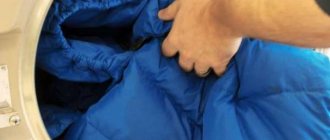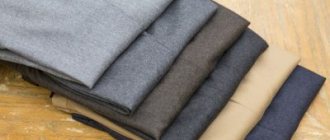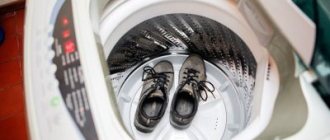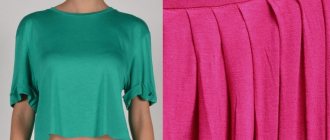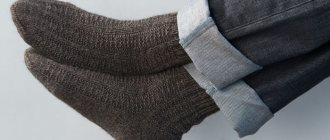How to wash linen?
Before washing the product, you need to select a washing powder. Regular powders that do not contain aggressive components are suitable for washing linen. Usually these are powders intended for washing children's clothes. Delicate laundry detergents are also suitable.
Since linen does not like harsh cleaning agents, bleaching powders or chlorine stain removers can ruin a linen item. This is especially true for colored and embroidered linen. For white linen, you can use oxygen bleaches; for colored linen, stain removers for colored fabrics. You can also use conditioners and other products that make the fabric softer, as well as water softeners.
Natural detergents for washing linen include soda ash and regular laundry soap. They create an alkaline environment in water and perfectly wash dense fibers of natural fabric.
Laundry soap also softens the material. A solution of potassium permanganate and laundry soap can easily cope with bleaching fabric. 3 tbsp will also help with this. l. hydrogen peroxide per 1 liter of water, if you soak things in this solution for a day. 1 tbsp. l. ammonia per 1 liter of water will bleach the fabric in just 3-4 hours of soaking.
Prevention of shrinkage
Items that are entirely made of linen often shrink due to heat treatment. This occurs due to the use of hot water, incorrect choice of powder or poor material. To avoid such a situation, you should strictly follow the recommendations:
- do not exceed the permissible temperature limit;
- choose high-quality fabric (with a smooth surface, dense weave of fibers and resistant color);
- Use only products that are specifically designed for this type of fabric.
How to wash white linen in a washing machine
The rules for washing white and colored linen items differ. High temperature will not damage white linen fabric. After such washing, things not only do not lose their quality, but also become softer and more pleasant to the touch, so the temperature can be set to 40-60°C, and, if necessary, even boiled.
Remember to look at the tag, as the product may not be 100% natural and may contain additional synthetic components. The maximum water temperature for washing is always indicated on the label.
It is recommended to choose a gentle mode for washing white linen in a washing machine - “Delicate” or “Hand Wash”. That is, one at which the car speed is not high. At high speeds, products can shrink, especially if they are completely natural.
After washing, things must be rinsed well, since the powder remaining on the fabric shortens the life of the product, the fabric oxidizes and ages.
In this case, you can use the extra rinse function. It is not advisable to use spinning at high speeds to avoid deformation of the product; you need to let the water drain from the fabric on its own.
Recommendations
The following tips will help you cope with washing linen:
- Due to its high absorbency, washing linen requires a lot of water.
- If you use a machine for washing, it is recommended not to load it completely. This will allow things to wash better.
- Before washing linen items, it is necessary to sort them, separating white and colored items.
- After washing, linen needs a good rinsing. When washing automatically, this is achieved by setting an additional rinse; when washing manually, by changing the water several times.
- A slight shrinkage after washing is natural for linen items, the material of which does not contain synthetic fibers.
If the treatment was carried out correctly, then when worn or ironed, linen clothing will return to its shape. The lower the percentage of synthetics in the fabric, the more shrinkage it can give. - After washing, you should not twist things; it is better to allow the water to drain freely.
- Pre-soaking items improves the quality of washing. After it, the item can be washed either by hand or in a machine.
- Washing linen is easier in soft water than in hard water.
- If you doubt the safety of a fabric stain remover, you should first test it on an inconspicuous area.
If linen fabric has embroidery, the item should not be soaked.
len-pri-stirke-1 len-pri-stirke-2
- Sort items by color: colored items should not be washed with white or light-colored items.
- Carefully read the composition of the material on the label. It also contains care instructions. Do not wash linen clothes together with items made from other fabrics.
- Gentle hand washing is recommended, but linen can also be washed in an automatic machine on one of the gentle cycles.
- Since linen absorbs water well, do not load the washing machine too much; if there are too many clothes and they absorb most of the water, the clothes will not wash well.
- You need to rinse linen clothes very carefully, since detergent particles remaining in the fibers can damage the structure of the fabric.
- If you need to use chemicals to remove heavy stains, check their effect on an inconspicuous area of the product - collar, inner seam, pocket. If the structure of the fabric is not disturbed and it does not “shed”, the entire product can be processed.
- Linen should also be dried and ironed according to the rules.
How to wash colored linen clothes in a washing machine
Rules for washing colored linen:
- Colored linen should be washed separately, as colored items may fade and stain whites.
- To maintain rich color, it is recommended to use powders for colored laundry that do not contain chlorine.
- You can use stain removers designed for colored laundry.
- Bleaching agents for colored linen are prohibited.
- Since linen absorbs moisture, there is no need to overload the washing machine; things should spin smoothly in the drum. Otherwise, the paint will appear in streaks on the fabric.
Hand washing: how to do it correctly?
Hand washing is preferable for any linen items. Sometimes there is a symbol on the label of a linen product that prohibits machine washing.
For hand washing, it is better to use powders intended for automatic washing machines, since they have reduced foaming.
This is important for linen materials because they need to be rinsed well.
If colored items are washed, it is recommended to carry out the last rinse in a solution of vinegar and water (1 tablespoon of vinegar per 1 liter of water). This will preserve the brightness and richness of the fabric. After washing, the product is not twisted, but lightly wrung out by hand.
Washing linen with embroidery
Embroidered linen clothing should only be washed by hand.
Embroidered products are not allowed:
- soak;
- boil;
- unscrew.
The water temperature should not be higher than 30°C so that the embroidery threads do not fade. When washing, you do not need to rub the fabric too much in the area of the pattern, so as not to spoil its shape and the quality of the threads. If heavily soiled, the product must be soaked for 10-15 minutes in warm soapy water with the addition of 1 tsp. salt per 1 liter of water, and then rub the cloth with light movements. After washing, the item should be rinsed thoroughly, changing the water several times.
Embroidered linen can also be machine washed. To do this you need:
- turn the product inside out;
- turn on the delicate washing mode;
- set the water temperature to 30°C;
- disable the spin function.
Properties of flax
Linen is translated from Latin as “the most useful”, this is no coincidence. It is considered one of the first “domesticated” plants and is valued for its medicinal properties. Thanks to the luxurious amount of vitamins and beneficial substances in its composition, flaxseed exhibits antibacterial and even antifungal properties.
For women over 30, flax seeds can reduce the risk of breast and intestinal cancer. In addition, the beneficial plant improves skin and hair color, not to mention its benefits for the intestines.
However, flax is used not only for treatment in folk and official medicine, but also for the manufacture of natural summer fabric. The sharply increased popularity of such material is understandable - more and more people are striving to be closer to nature. Linen is best suited for this.
Due to its properties, it is used in many areas. This can be either tailoring or making bed linen, tablecloths, etc.
How to properly remove stains from linen products
To remove stains from natural materials, stain removers from stores whose instructions allow use for linen are quite suitable.
Before using the product on colored material, you must make sure that it is suitable for the painted product. To do this you need:
- apply a drop of product to the reverse side of the product;
- wait 3-5 minutes;
- rinse the item;
- see if the color has changed.
If everything is in order, the stain remover can be used.
When removing a stain you need:
- apply a little product to the product;
- wash it by hand or in a washing machine;
- rinse thoroughly.
It is not recommended to add stain remover to the washing machine drum.
How to properly wash linen items so they don’t shrink
To prevent linen from losing its shape and becoming deformed, washing should be carried out at a temperature no higher than 30°C-40°C. You should know that things with the addition of synthetic fabrics practically do not shrink.
It will eliminate shrinkage and purchase high-quality products that undergo special processing before sale. After this treatment, the fabric also does not shrink.
In order for linen to shrink, you need to wash it in hot water. The need for shrinkage arises, for example, before sewing products made from all-natural linen.
This material must be washed before sewing and cutting. More precisely, do not wash it, but soak it in hot water for 10-15 minutes.
After this, the fabric needs to be dried, ironed and re-measured (the fabric will certainly shrink and change length or width). This procedure is done in order to take into account the degree of shrinkage of the material and sew the item exactly the size that is needed.
What to do if the flax does shrink?
Products that contain, in addition to flax, synthetic fibers will not shrink (or shrink very slightly) even when washed in hot water. All-natural linen can shrink if you wash the product in water above 60°C. Sometimes, in order for an item to take its original shape, it is enough to iron it through gauze, folded several times, and try on the clothes. After trying on the item may stretch.
Some useful tips for caring for linen fabric are in the video.
Nuances
Linen is prone to color loss and shrinkage. Removing stains can damage the fabric. Let's talk about possible risks.
Coloring
If you wash linen clothes incorrectly, they may become stained. Therefore, the use of powders with colored granules is not recommended. Hand washing requires more water to allow clothes to float freely. Lack of water can lead to shedding. When rinsing, be sure to wash the item until the foam is washed off.
Recommendation! In order not to lose the rich shade of the fabric, when rinsing, add 1 glass of vinegar to the water, and no Lenor will be needed.
Shrinkage
Let's figure out how to wash linen so that it doesn't shrink. If the material does not contain synthetic additives, this leads to shrinkage. But after the first wear, the item will return to its original appearance. To make the item recover faster, try gently ironing it through a piece of gauze.
How to dry and iron linen items
After the product has been washed (regardless of whether the linen is light or colored, with or without embroidery), it must not be twisted or wrung out. After lightly squeezing the material with your hands, it needs to be straightened, shaped and hung out to dry.
Drying
It is not recommended to dry linen items in direct sunlight, especially colored ones. They fade quickly, the sun destroys the fibers of the fabric. Over-drying damages natural fibers, which can cause the material to become brittle. But a ventilated place with good air circulation is necessary when drying linen items. They will retain their quality and will not lose their shape. It is better to remove dried products when they are still slightly damp.
Ironing
Iron wet items with a hot iron without letting them dry completely. It is necessary to iron already dried material using a spray bottle of water to spray the fabric, or the steam mode of the iron.
Features of ironing linen products:
- Light-colored items are ironed first from the wrong side, then from the front.
- Dark - only with the wrong side.
- Embroidered items should be ironed from the inside out on a soft surface. To maintain the volume of embroidery, you need to place it on the embroidered area, then move it to the adjacent one.
- It is recommended to leave the ironed product in a horizontal position until completely dry and cool.
If, when caring for linen clothing, you follow all the recommendations correctly, linen items will reward you with wear resistance and comfort to wear.
Decorating fabrics before cutting
Decatting is a wet-heat treatment of fabrics to shrink them before cutting the product. All fabrics that contain 50 percent or more natural fibers are decatified. These are wool, linen, cotton, hemp, silk, and rayon fabrics. If the product that you plan to sew will be washed, decating is required. If you plan to dry clean (coats, suits), simply iron and steam the fabric.
Cotton and linen fabrics are soaked, dried and ironed slightly damp. The silk is soaked and dried. Do not iron with a hot iron. Silk fabrics that may fade are moistened by using a damp sheet in which the silk fabric is wrapped before ironing. Plain silk fabrics are ironed without steam on the reverse side to avoid stains.
For woolen fabrics, moisten the underside with a sprayer. After 8-12 hours folded, the fabric is ironed from the inside out. Thin woolen and wool-blend fabrics simply need to be ironed through a damp cloth.
